5 Best SEO Audit Tools for More Traffic
SEO audit tools reveal hidden issues and opportunities on your site. Backlinko uses these tools for in-depth SEO audits every year. And quarterly check-ins. This analytical approach has helped us maintain top rankings and grow organic traffic by 20.50%...

SEO audit tools reveal hidden issues and opportunities on your site.
Backlinko uses these tools for in-depth SEO audits every year. And quarterly check-ins.
This analytical approach has helped us maintain top rankings and grow organic traffic by 20.50% year over year.
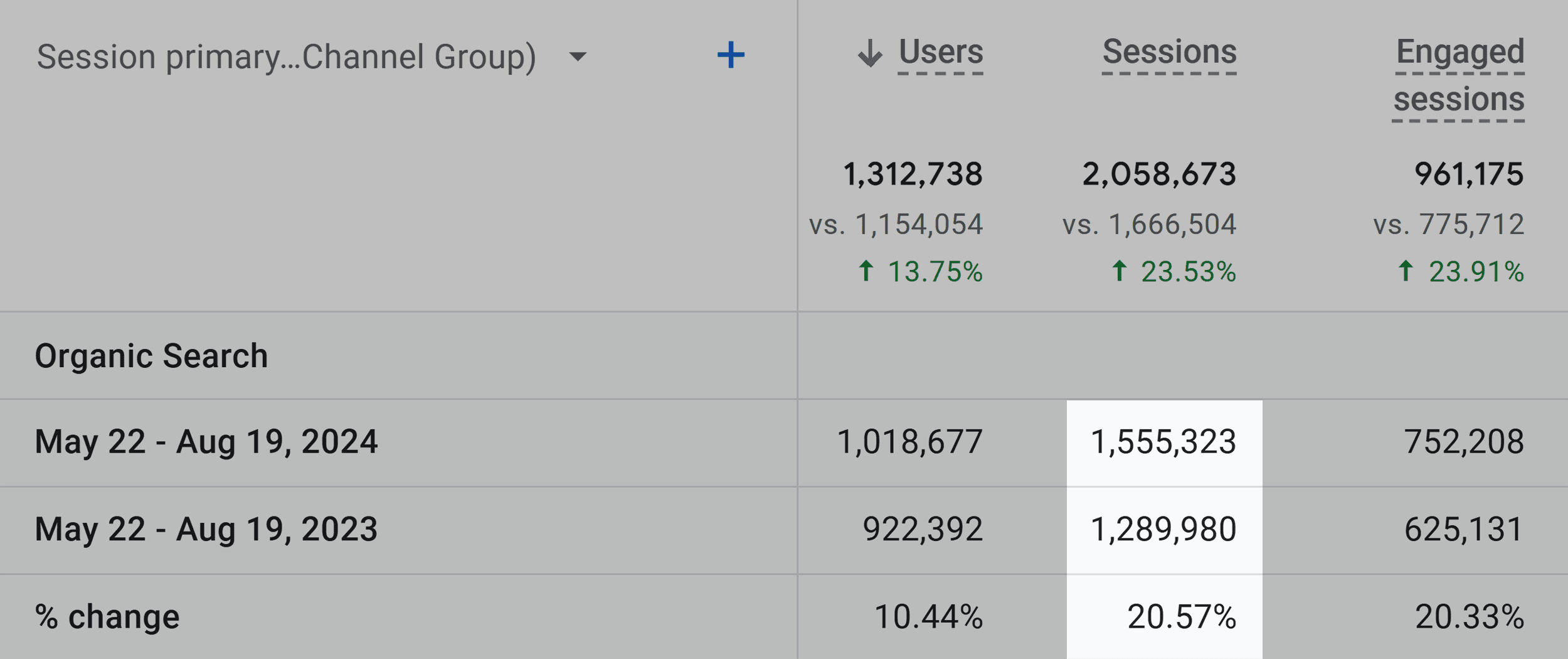
We run a fresh site crawl, review top pages, and optimize them to keep our search rankings high.
You can do this for your website, too.
To assist, we’ve reviewed five top SEO audit tools to help you improve your website’s search performance.
What Are the Best SEO Audit Tools?
The SEO audit tool you choose depends on your needs. But here are five of the best SEO audit tools we recommend (that cover most areas):
What to Look for in SEO Audit Tools
SEO audit tools have a lot of different features. Here are the top functions to add to your shopping list:
Comprehensive crawling: The ability to thoroughly crawl your entire website, including all pages, links, and images to identify technical errors. To get this, make sure the plan you choose has a crawl limit that exceeds the number of pages on your website. Technical SEO analysis: Identification and prioritization of technical issues like broken links, duplicate content, missing meta tags, and page speed problems Actionable recommendations: Clear guidance on which issues to address in order to improve SEO performance. Ideally, with prioritization and basic instructions. Backlink analysis: Insights into your backlink profile, including the number of links you have and the quality of each Reporting and visualization: Clear and concise reports that highlight key issues Integration with other tools: The ability to connect with other SEO tools like Google Search Console and Google AnalyticsWith these qualities in mind, let’s look at why each tool made our final list.
1. Semrush’s Site Audit
Best for identifying technical SEO issues on the site.

Semrush’s Site Audit tool lets you identify and fix over 140 potential technical SEO issues. Use this tool to:
Check Every Page on Your Website
In your Semrush dashboard, locate the “ON PAGE & TECH SEO” section in the left-side menu. Then click on “Site Audit.”

Enter your domain and click “Start Audit.”

The tool will analyze your site and generate a series of reports. Like this:
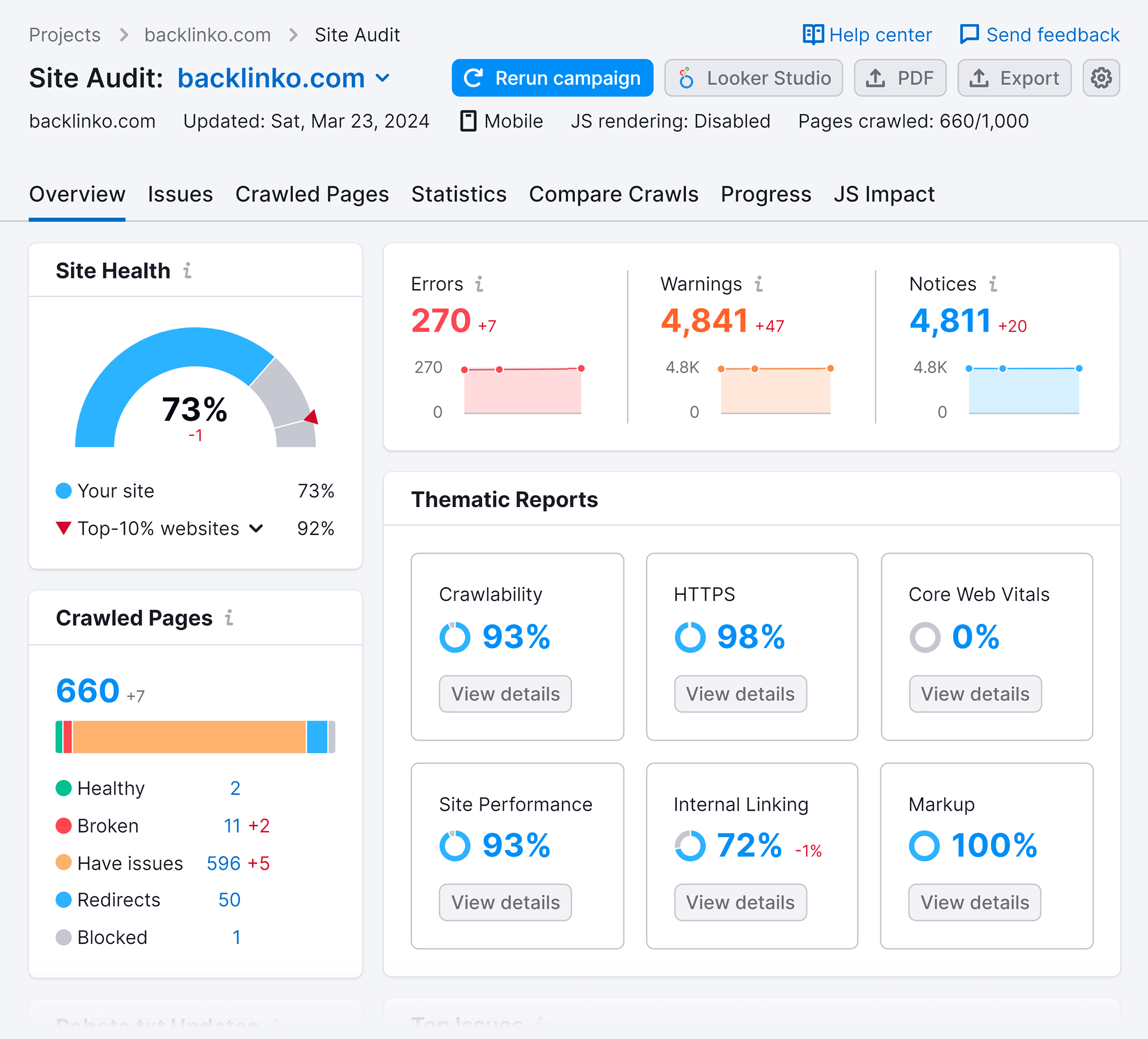
This tool provides an overall assessment of your site’s health. And breaks the data down into seven “Thematic Reports.”
They include:
Crawlability: How easily search engines can access and index your site’s content HTTPS: Whether your site uses a secure connection (HTTPS) to protect user data International SEO: How well your site is optimized for different languages and regions Core Web Vitals (CWV): Key user experience metrics that measure your site’s loading performance, interactivity, and visual stability Site Performance: Overall speed and responsiveness of your site Internal Linking: How well your pages are linked together to facilitate user navigation and help search engines understand your content Markup: The degree to which you’ve used structured data to provide additional information to search engines about your contentClick the “View details” button in each report to see a detailed analysis related to that aspect.
For example: Clicking “View details” for the “Crawlability” report will show you how many pages on your website are indexable vs non-indexable.
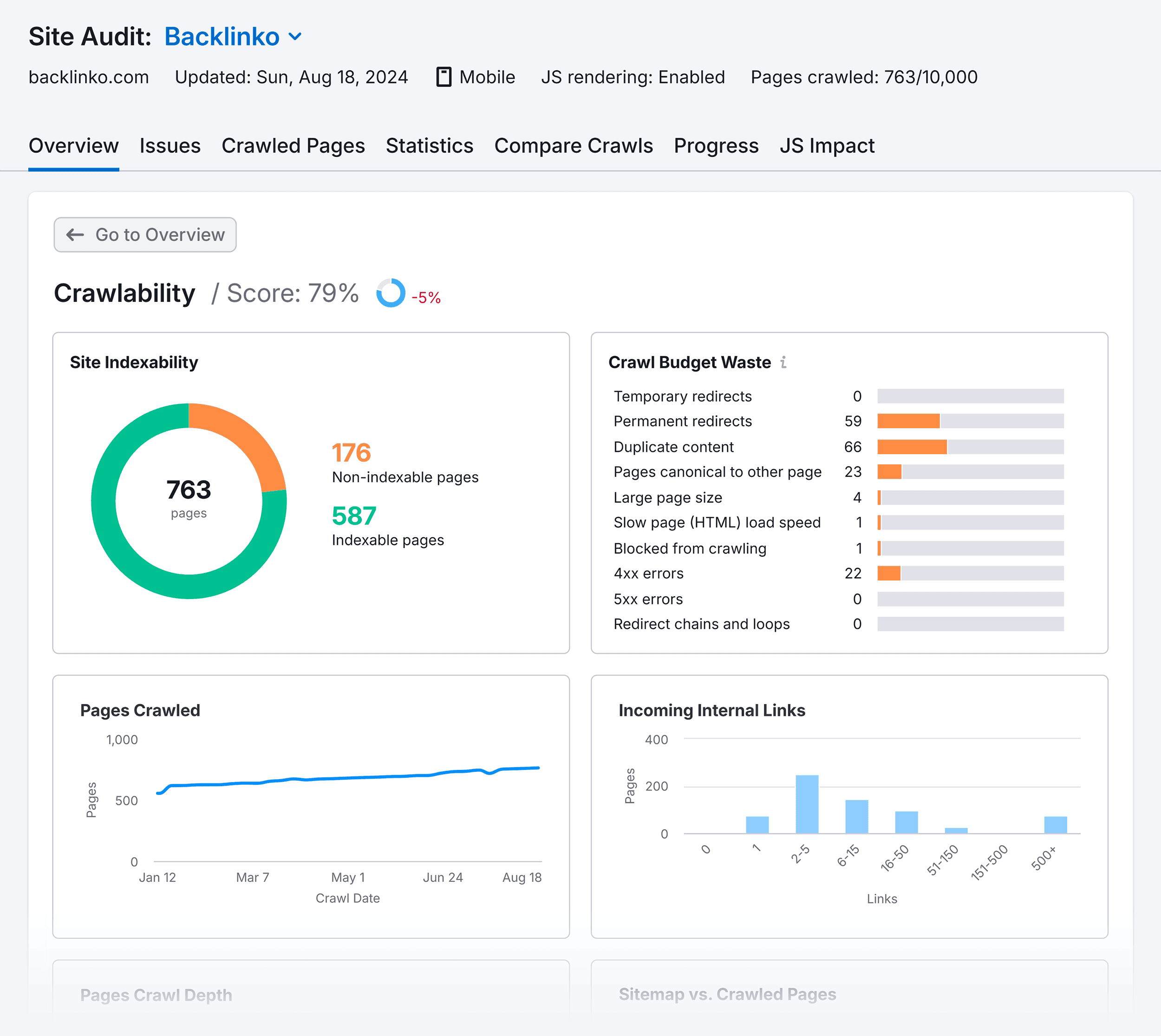
Get a Prioritized List of Issues and Recommendations
Return to the main report page by clicking the “Overview” tab. Then click the number in the “Errors” report.

This will take you to a list of all the errors Semrush found on your website.
Click the “Why and how to fix it” link next to the error you’d like to learn more about. You’ll get detailed information about why you should fix the specific issue and how to do it.
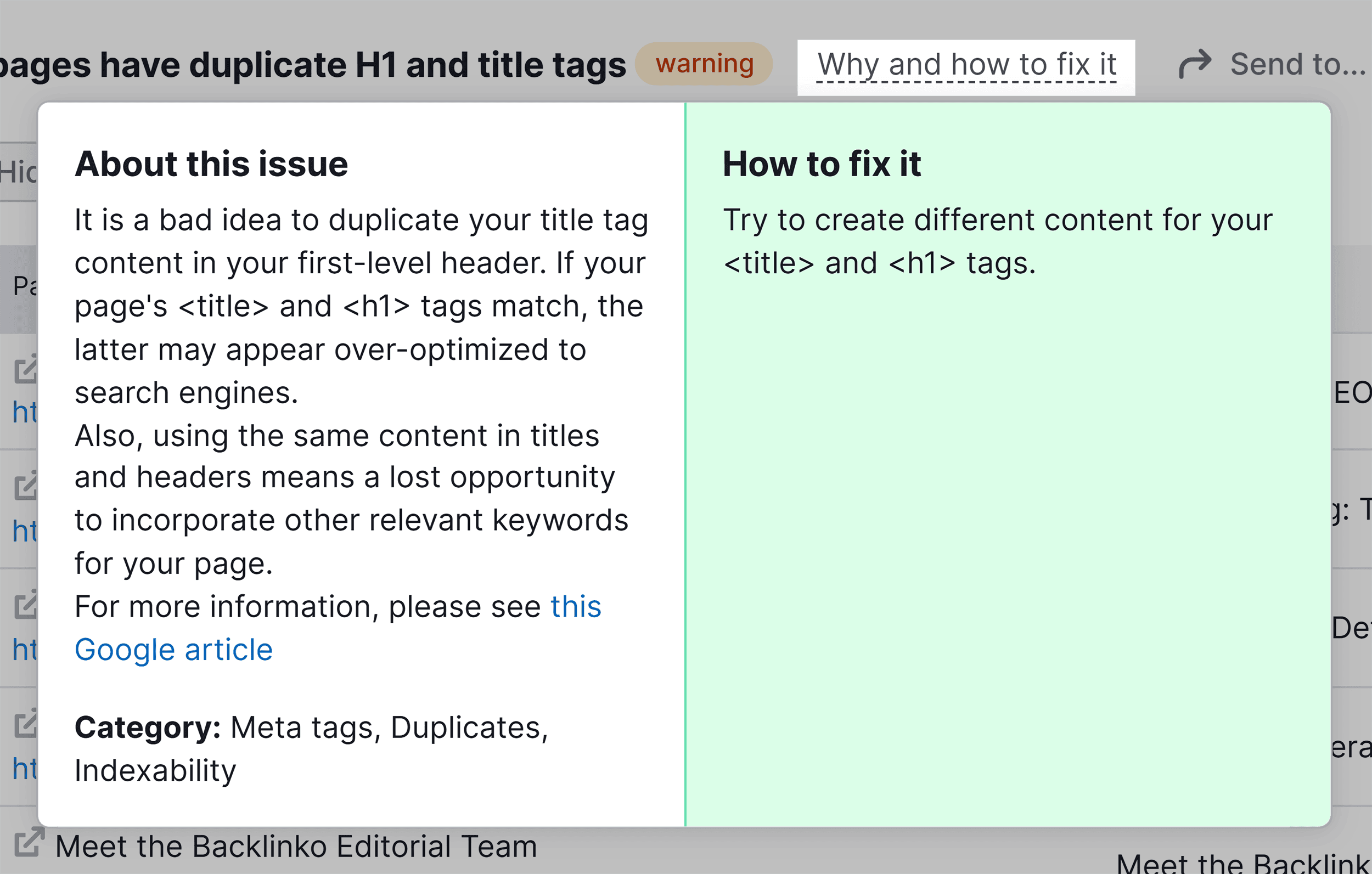
Then, follow Semrush’s recommendations and fix the issues one by one to improve your SEO.
Share the List of Issues
If you’d like to share the list of detected issues, like with an SEO team or a client, click the “Export” button in the top-right corner of the page. Then click “Export to XLSX” or “Export to CSV” depending on the file format you prefer.

Send the file via email or messenger of your choice.
Schedule an SEO Analysis
From the site audit page, click “Settings” (gear icon in the upper right). Then, click “Crawl sources: Website” (or any other option under the “Site Audit settings” section).
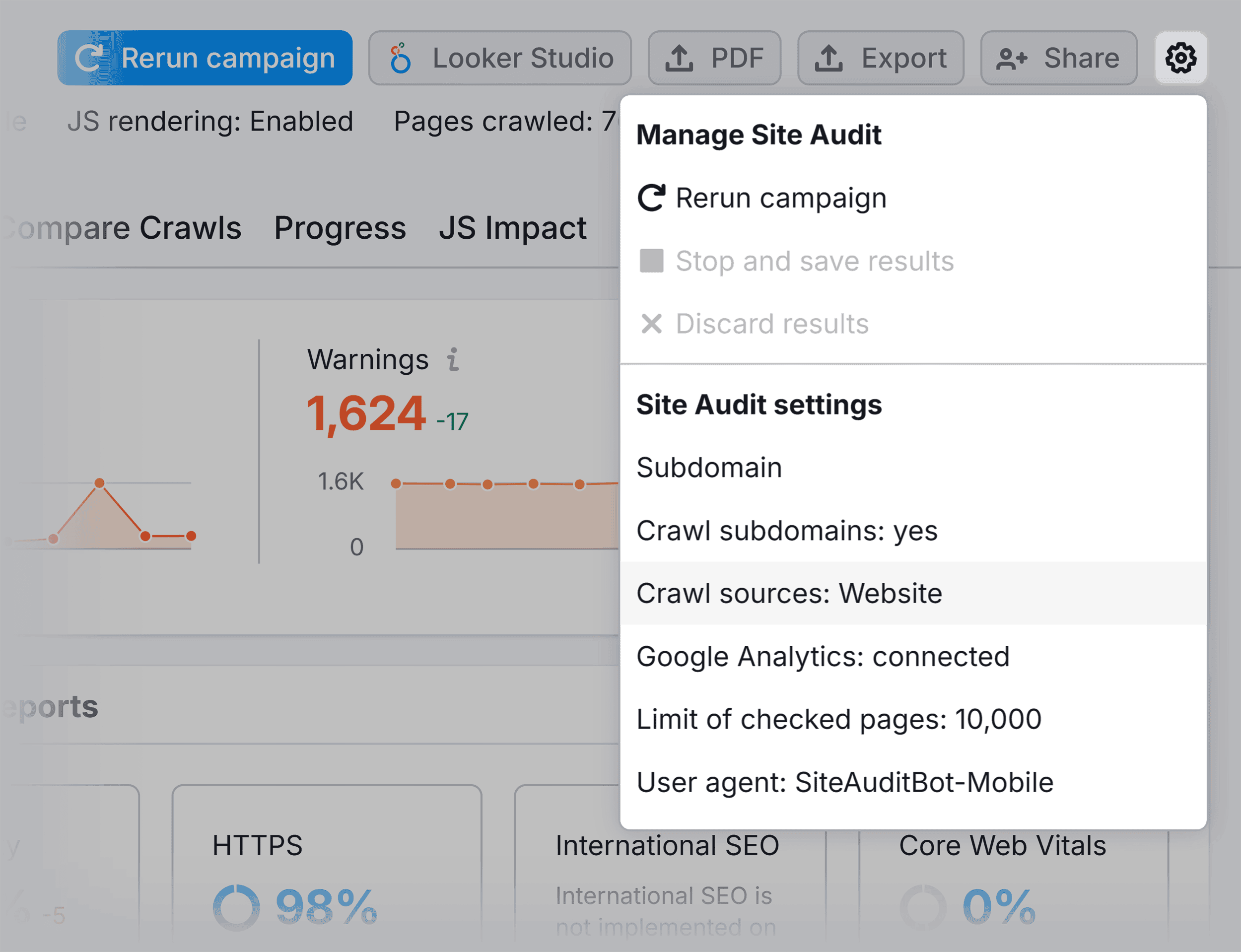
Optionally, you can configure your site audit by adjusting crawler settings, allowing/disallowing URLs, removing URL parameters, or bypassing website restrictions on the various tabs of the “Site Audit settings” menu.
Once your audit is set up the way you’d like, click the “Schedule” tab in the purple navigation menu. Use the drop-down menu to select your audit frequency. Tick the checkbox if you want to receive reports via email. And finally, click “Save.”

Pros and Cons
| Get prioritized list of issues | Pricing can be high for some |
| Get suggested ideas to improve your SEO |
Price
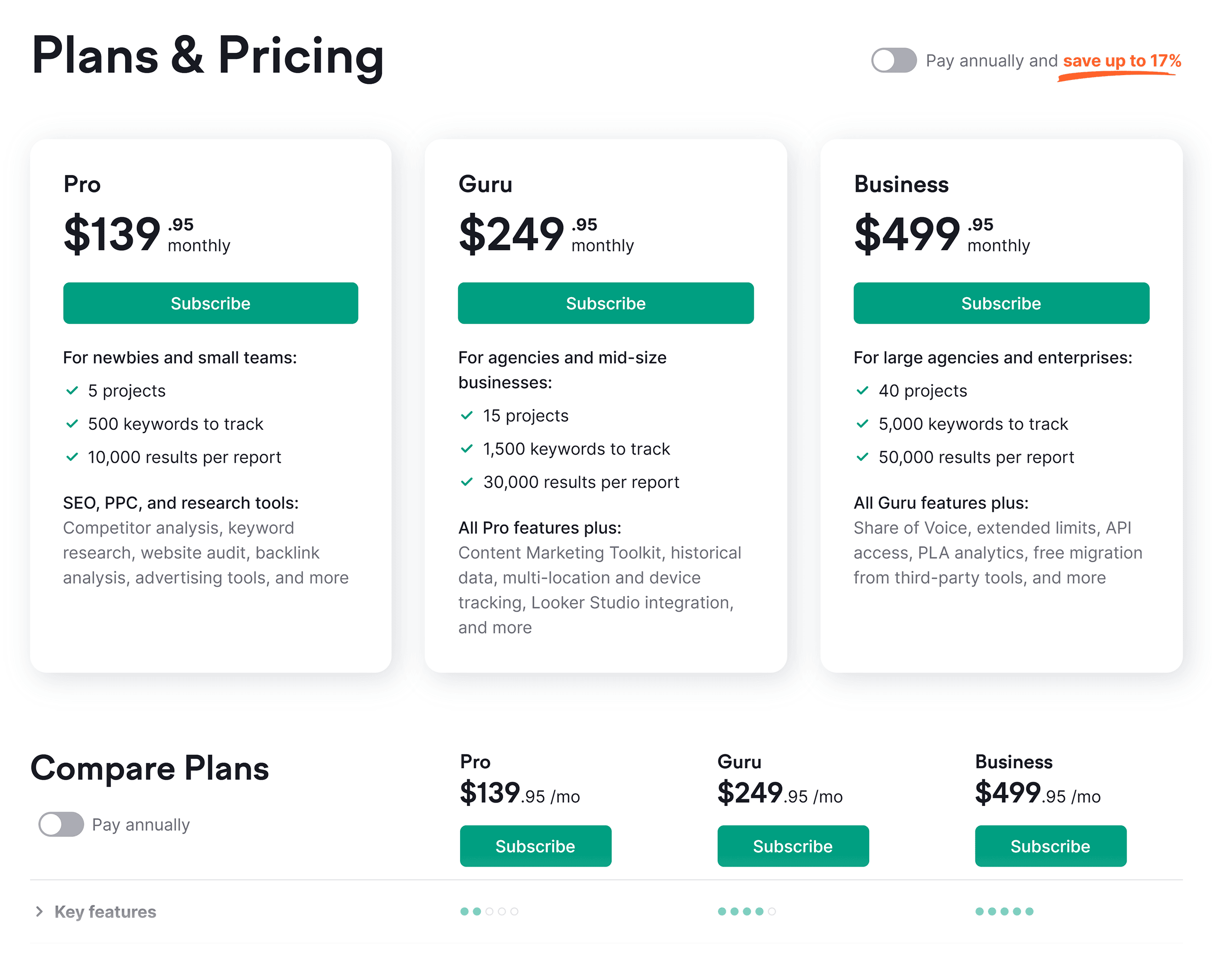
Semrush offers four plans:
Free: Get a site audit for one website Pro: For $139.95 per month, audit up to five websites Guru: For $249.95 per month, audit up to 15 websites Business: For $499.95 per month, audit up to 40 websites2. Screaming Frog
Best for identifying advanced technical SEO issues.

Compared to other SEO tools, Screaming Frog digs deeper into your website’s on-page and technical structure.
In addition to basic challenges, Screaming Frog identifies advanced technical issues like:
Canonicalization issues: Problems with the way you’re indicating the preferred version of a page to search engines Hreflang issues: Errors in the hreflang tags used to indicate language and regional targeting for international websitesUse this tool to:
Identify Technical SEO Issues and Ways to Fix Them
Open the Screaming Frog app on your computer. Insert your domain in the search bar and click “Start.”

Once the Screaming Frog crawl is complete, click the “Issues” tab in the top navigation on the right side of the screen.
This section shows you all the issues found on your website.
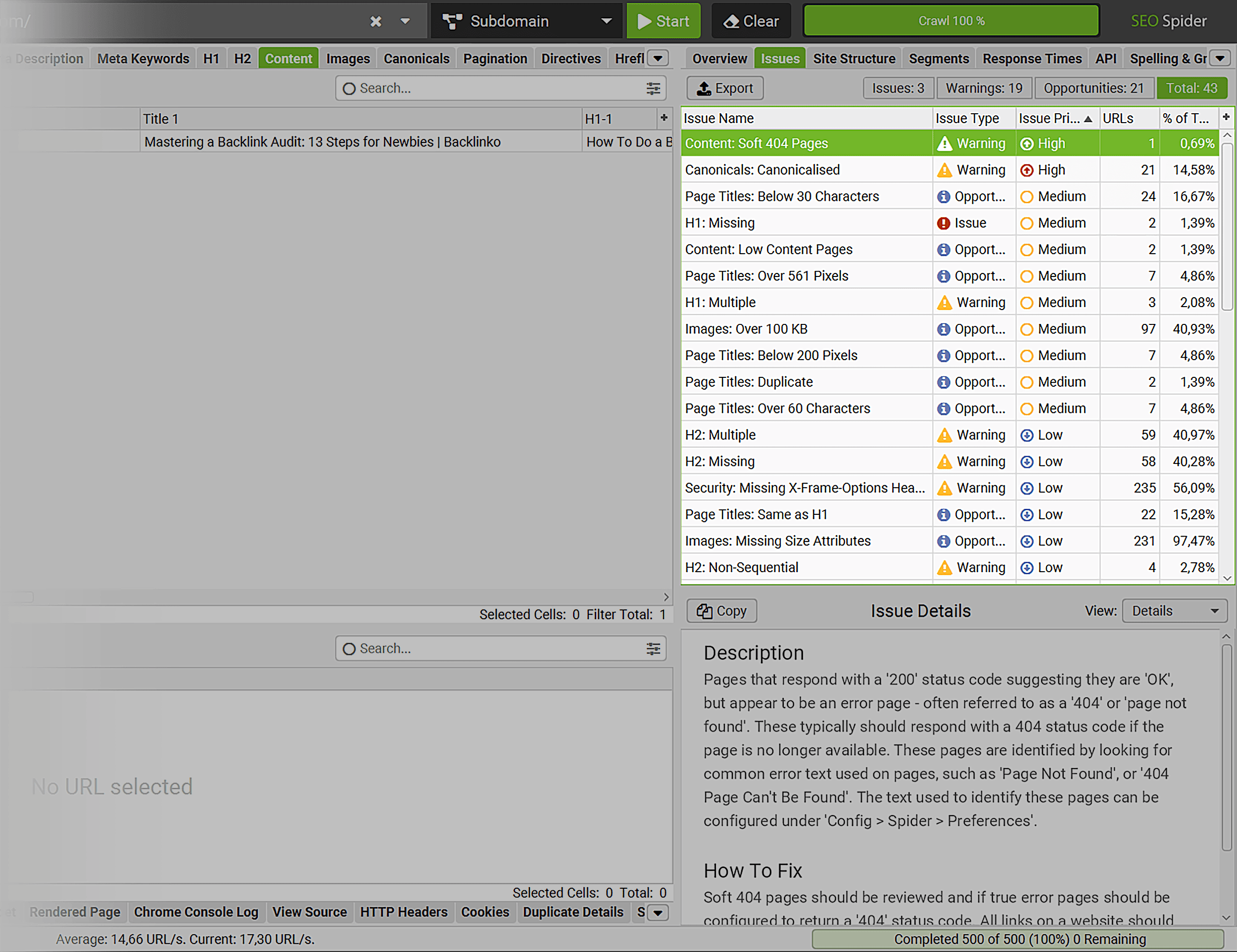
Click each issue to review its details and suggested fixes:
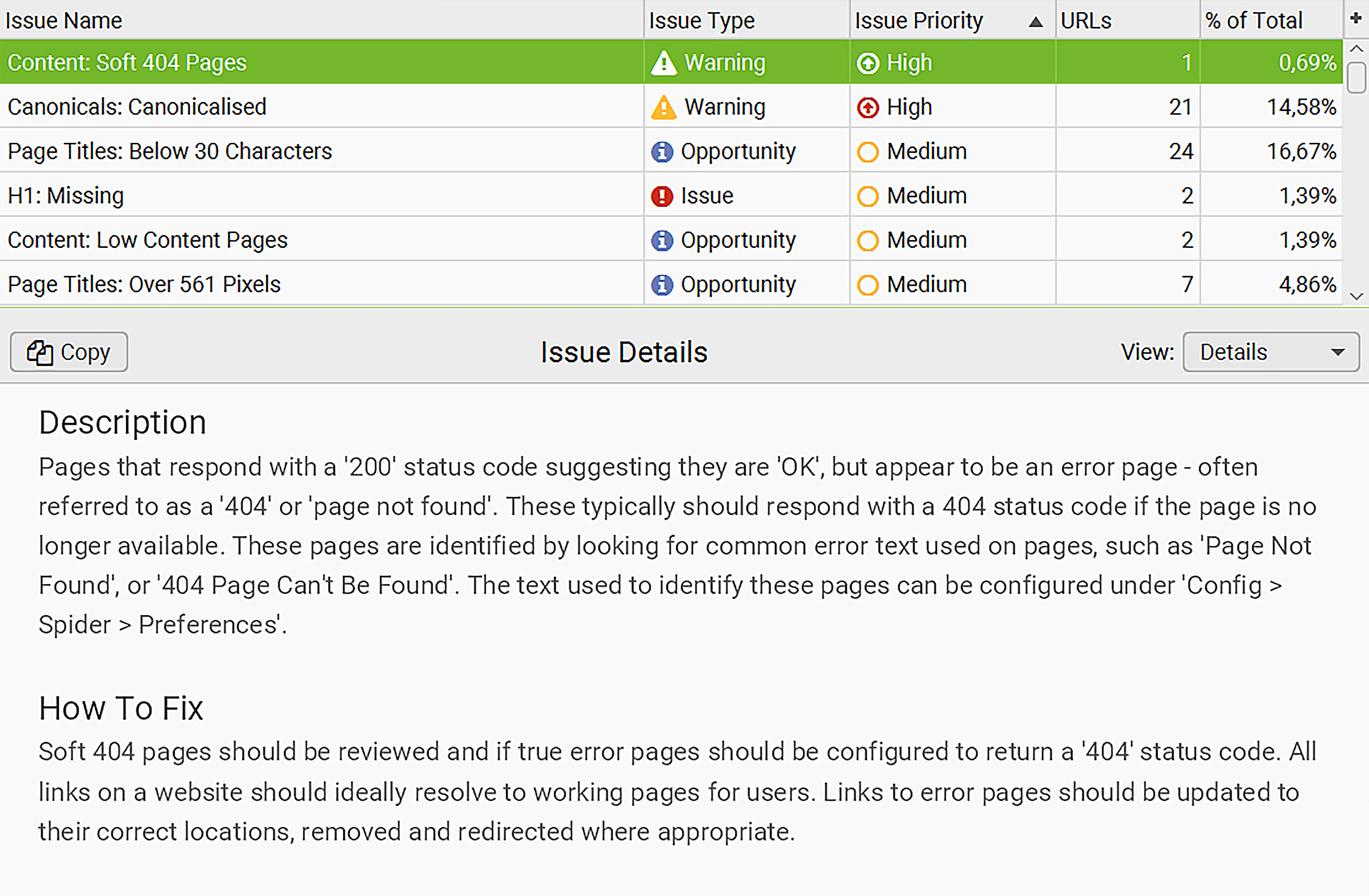
Audit Hreflang Attributes
Select the “Overview” tab in the top navigation on the right side of the screen and find “Hreflang” group. Then, review the URLs with hreflang attributes.

Pros and Cons
| Offers high level of granularity when assessing the pages of your website | Since it’s a desktop app, you can only access your SEO audit from your computer |
| Identify important technical SEO issues and get suggestions to fix them | It can slow down your computer while crawling large websites |
Price

Screaming Frog offers two simple plans:
Free Version: Crawls 500 URLs on your website Paid Version: $259 per year per license. Crawls unlimited URLs on your website.3. SE Ranking’s Website Audit
Best for auditing multiple client websites with ease.
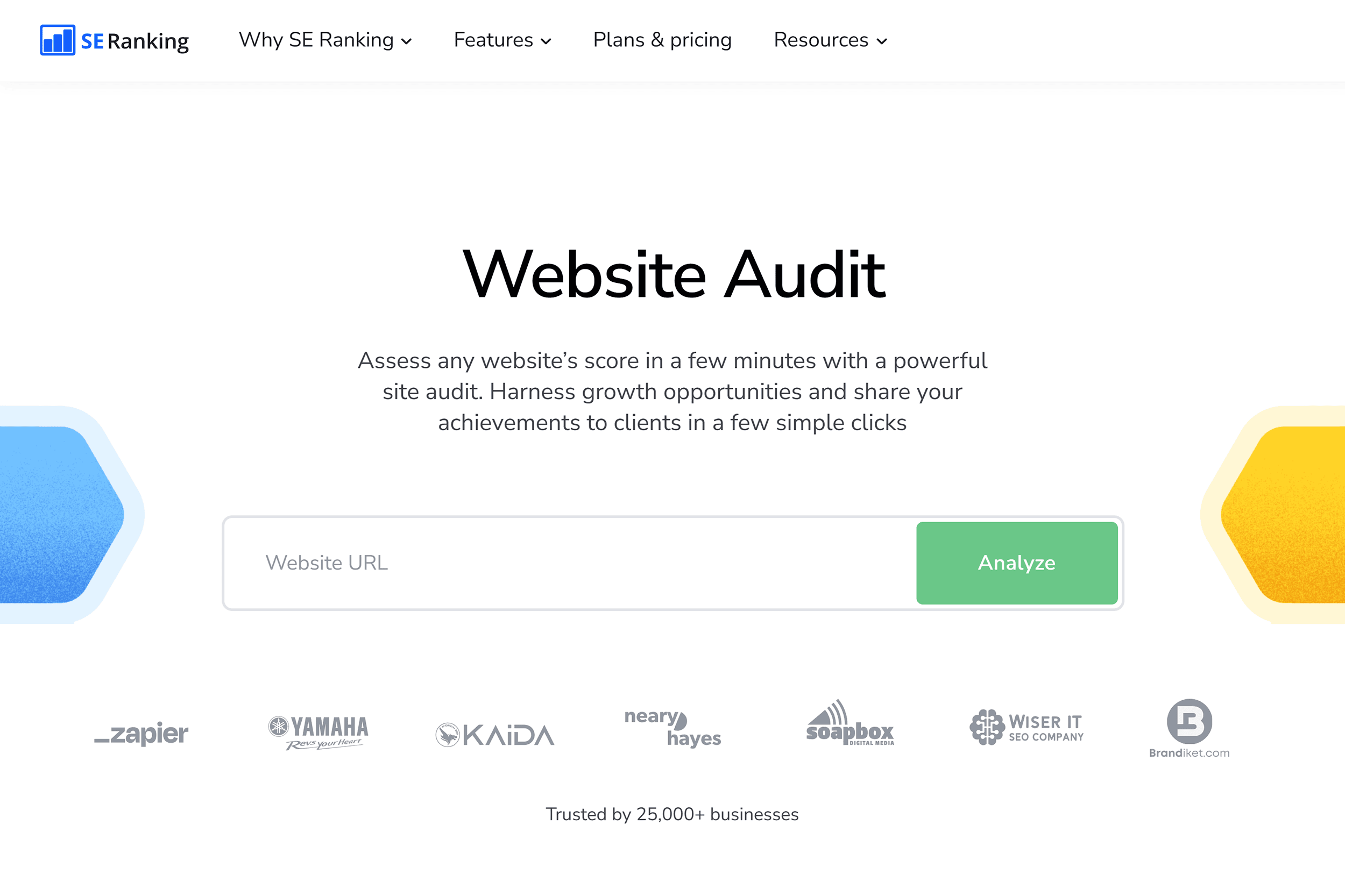
SE Ranking’s Website Audit tool helps you quickly assess technical SEO on your clients’ websites. You can find issues that could hurt your search results performance. Such as:
Broken links Missing metadata Duplicate content Slow page speedUse this tool to:
Identify SEO Issues
To start auditing a website, navigate to “Audit” > “All reports” from the left-side menu.

Click the “+ NEW AUDIT” button. Enter the domain and name your audit. Choose where to save it and, if you like, provide instructions about which pages to audit. When settings are complete, click “RUN AUDIT.”

Once SE Ranking crawls all the pages (which can take up to 10 minutes), it provides an illustrated overview.
Here, you’ll see the website’s health score, Core Web Vitals overview, and issues.
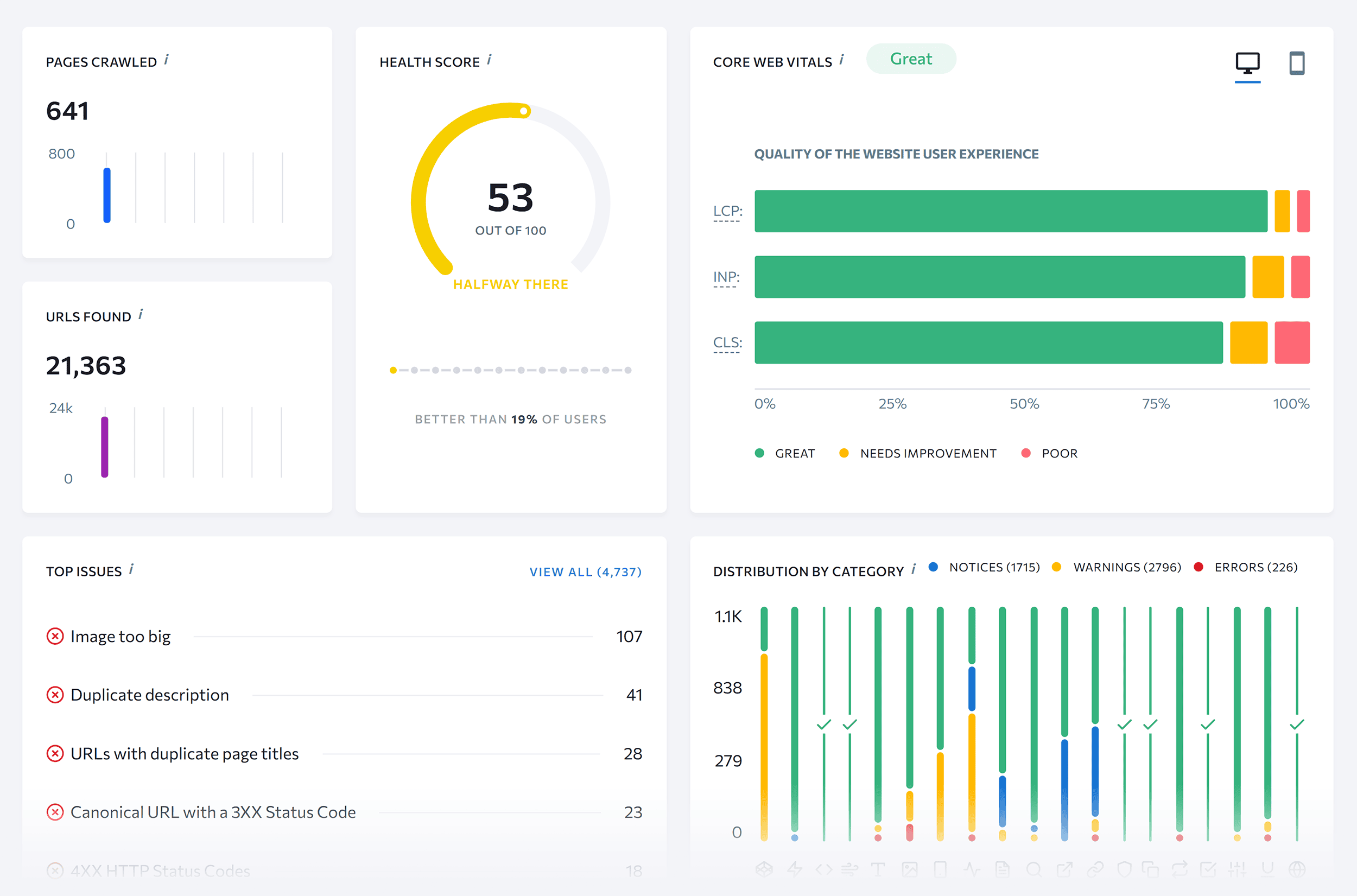
Click “VIEW ALL” in the “Top Issues” section to review crucial issues on the website.
The tool sorts issues by category (like website security and duplicate content). And importance (like errors, warnings, and notices).
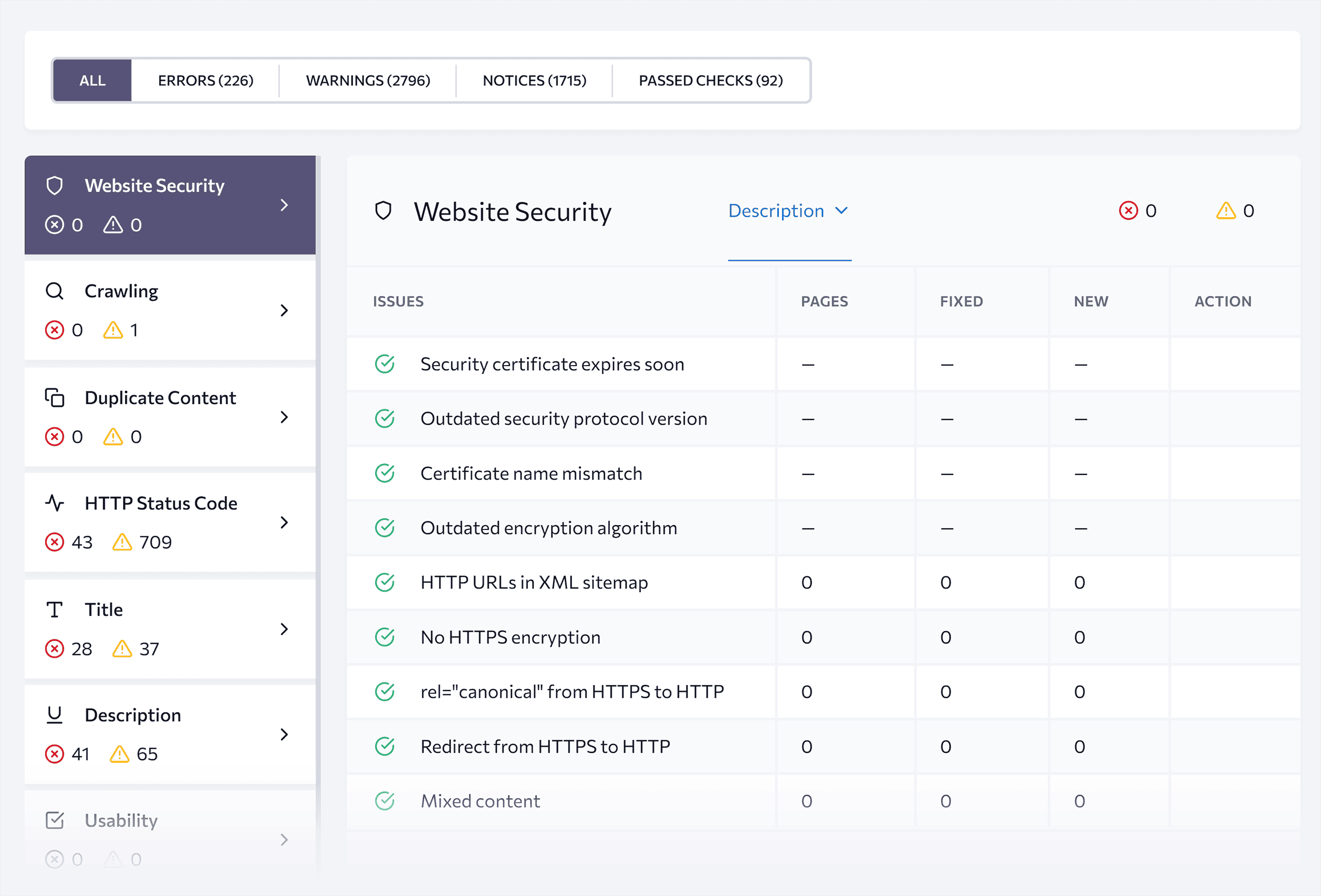
Let’s say you want to investigate important issues. Click the issue group (like “HTTP Status Code”) and click one of the issues marked with the red icon (like “4XX HTTP Status Codes”).
Read the issue description to understand its importance. Then move on to the “How to fix” section for actionable tips to solve the issue.
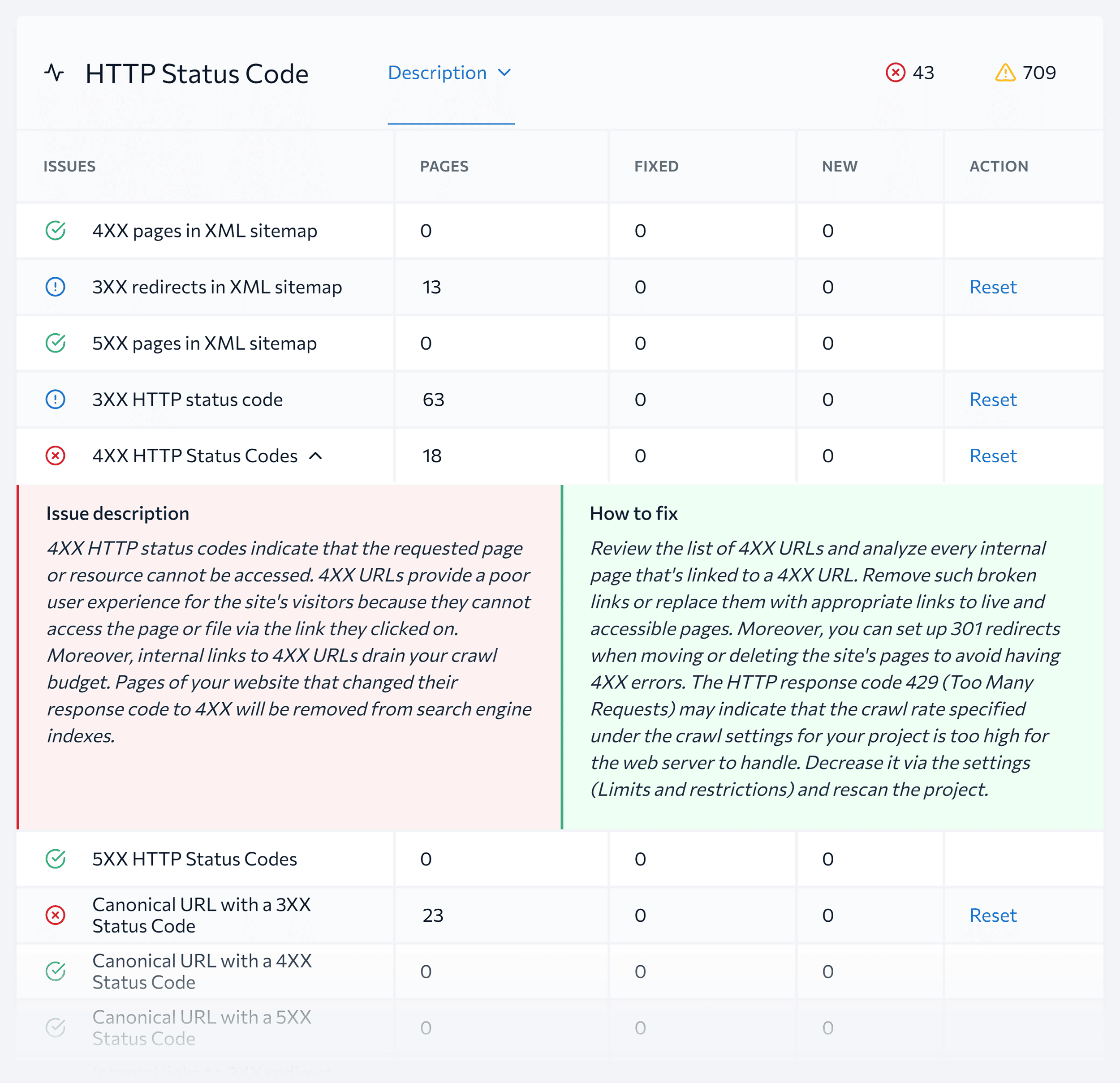
Sort Individual Audits into Groups
One of the standout features SE Ranking’s Website Audit tool offers is its ability to group web assets.
Navigate to “Website Audit” from the left-side menu and click the “+ NEW AUDIT” button in the upper right.
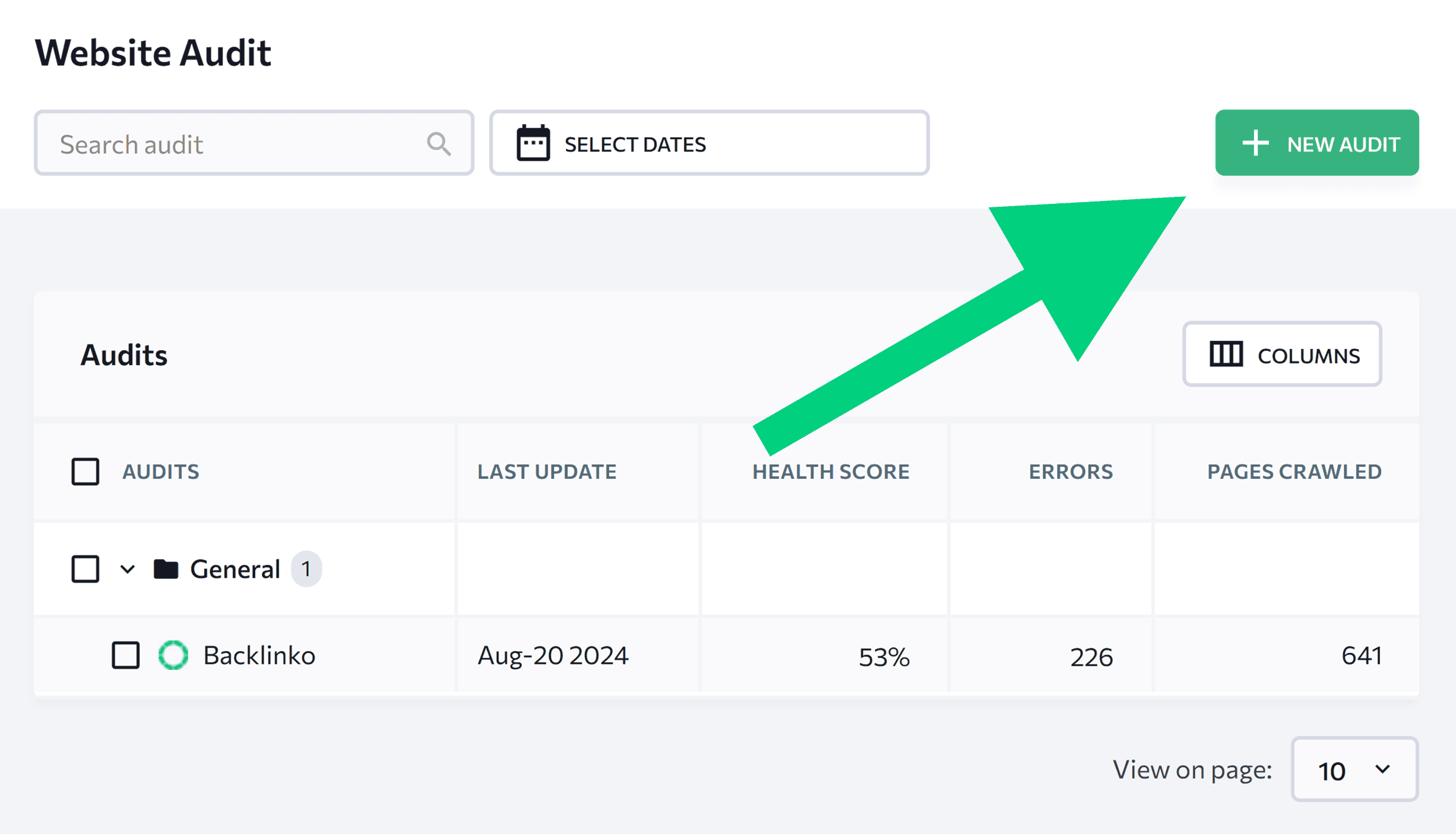
Insert your client’s domain. Then, name your audit and use the drop-down to create a new group for it.
For example, you could create a group “Local Businesses” to help sort your clients based on their business type.
When you’re all set, click the “RUN AUDIT” button.

Now, you have two groups. One general purpose, and one for whichever category you just created.
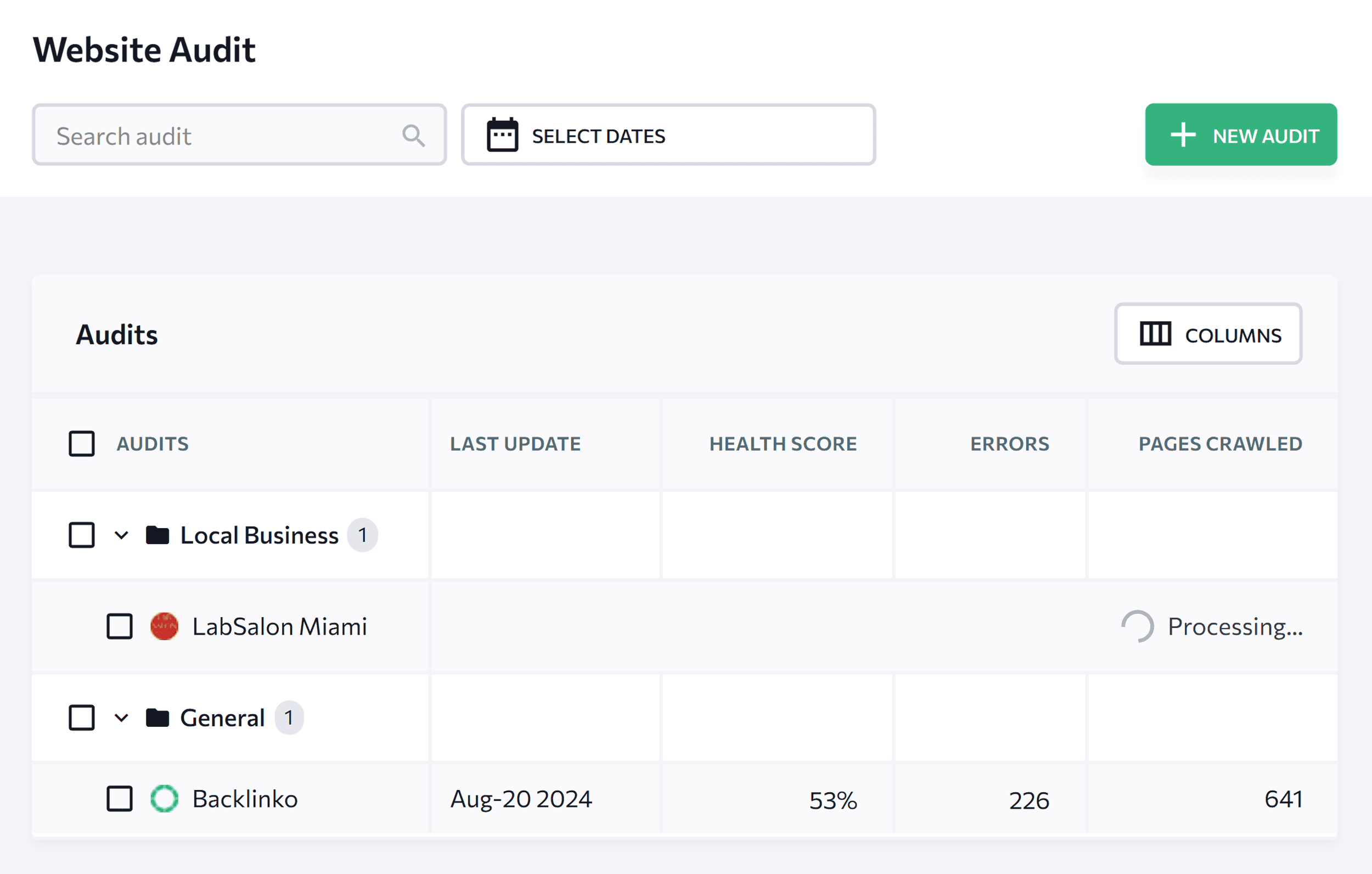
Build White Label Reports
Click “Report Builder” in the left side menu. Then click the “CREATE REPORT” button in the upper right.

Select your project and the date range of the audit. Choose a desired export format (like PDF, XLS, or HTML).
Optionally, schedule your report to be generated daily, weekly, or monthly.
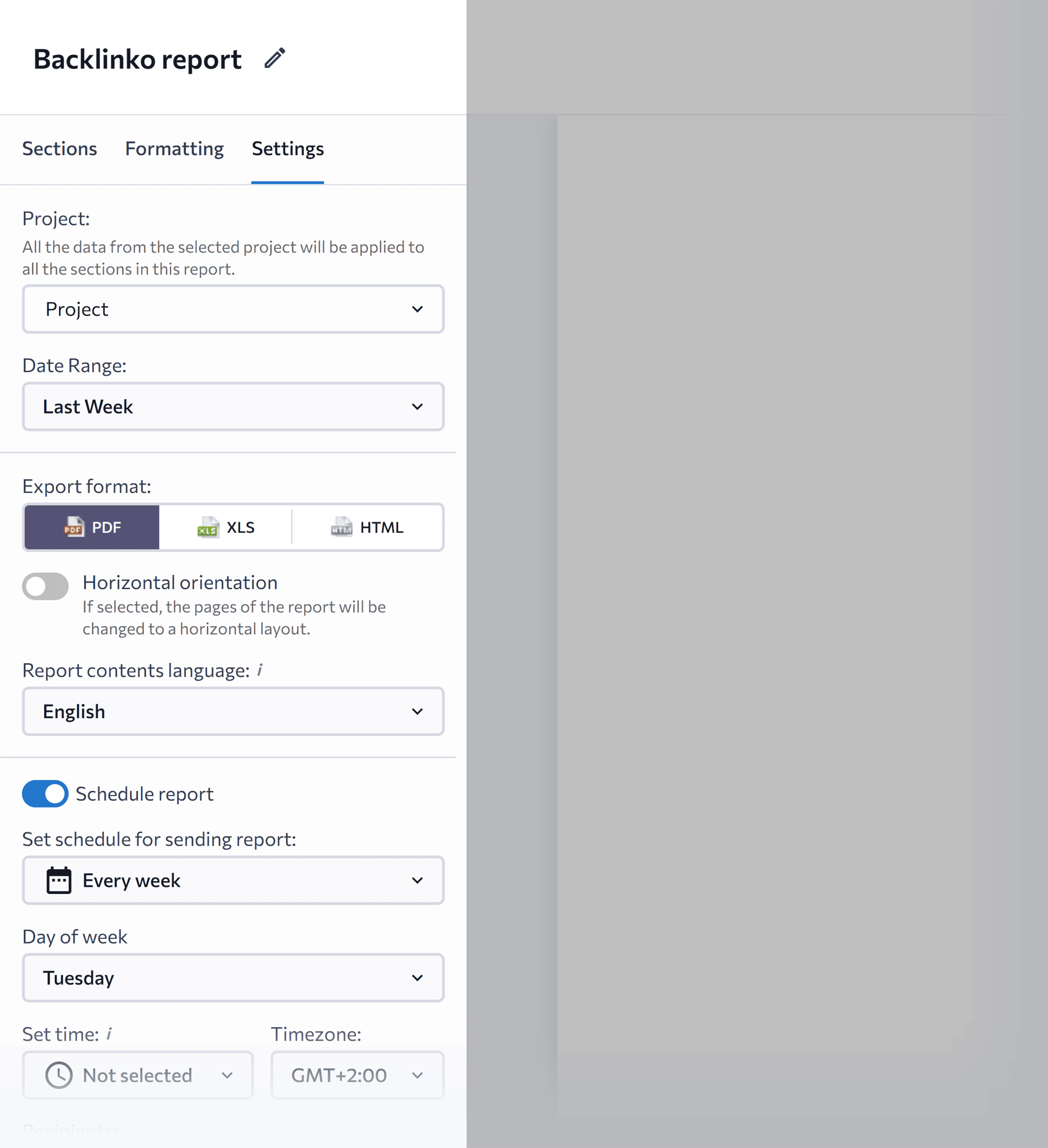
Next, click the “Formatting” section to create a layout for your report.
For example, click “Title” to insert the audit title. Like so:
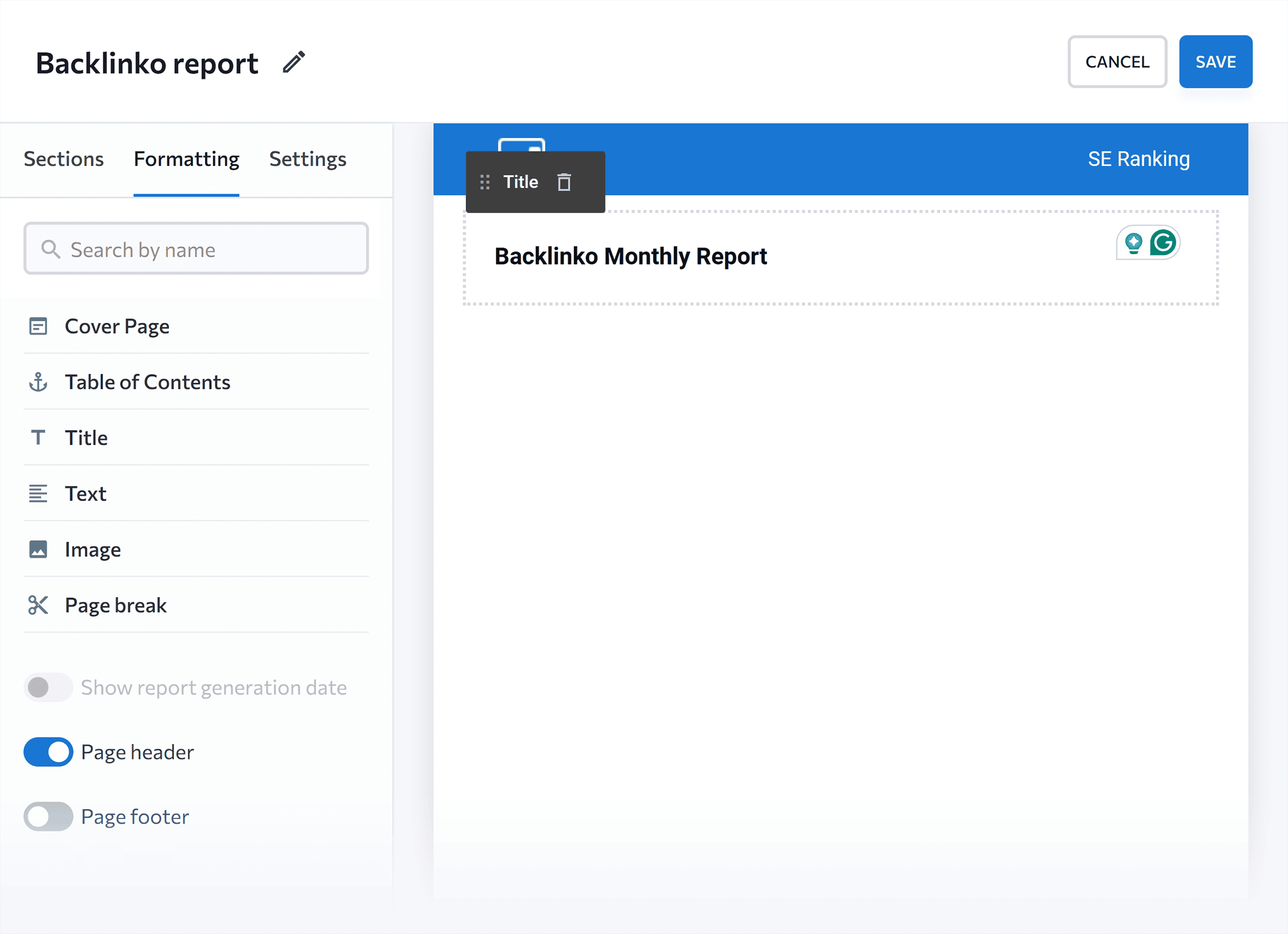
Switch to the “Sections” tab to add audit elements to your report.

Add any elements you’d like to include in your report.
Replace SE Ranking branding with your own logo and company name. This feature is included in the Pro plan.

Once you’re all set, click the “SAVE” button in the upper right.
Pros and Cons
| Group multiple websites together | The variety of features can be overwhelming for beginners |
| White label your SEO reports |
Price
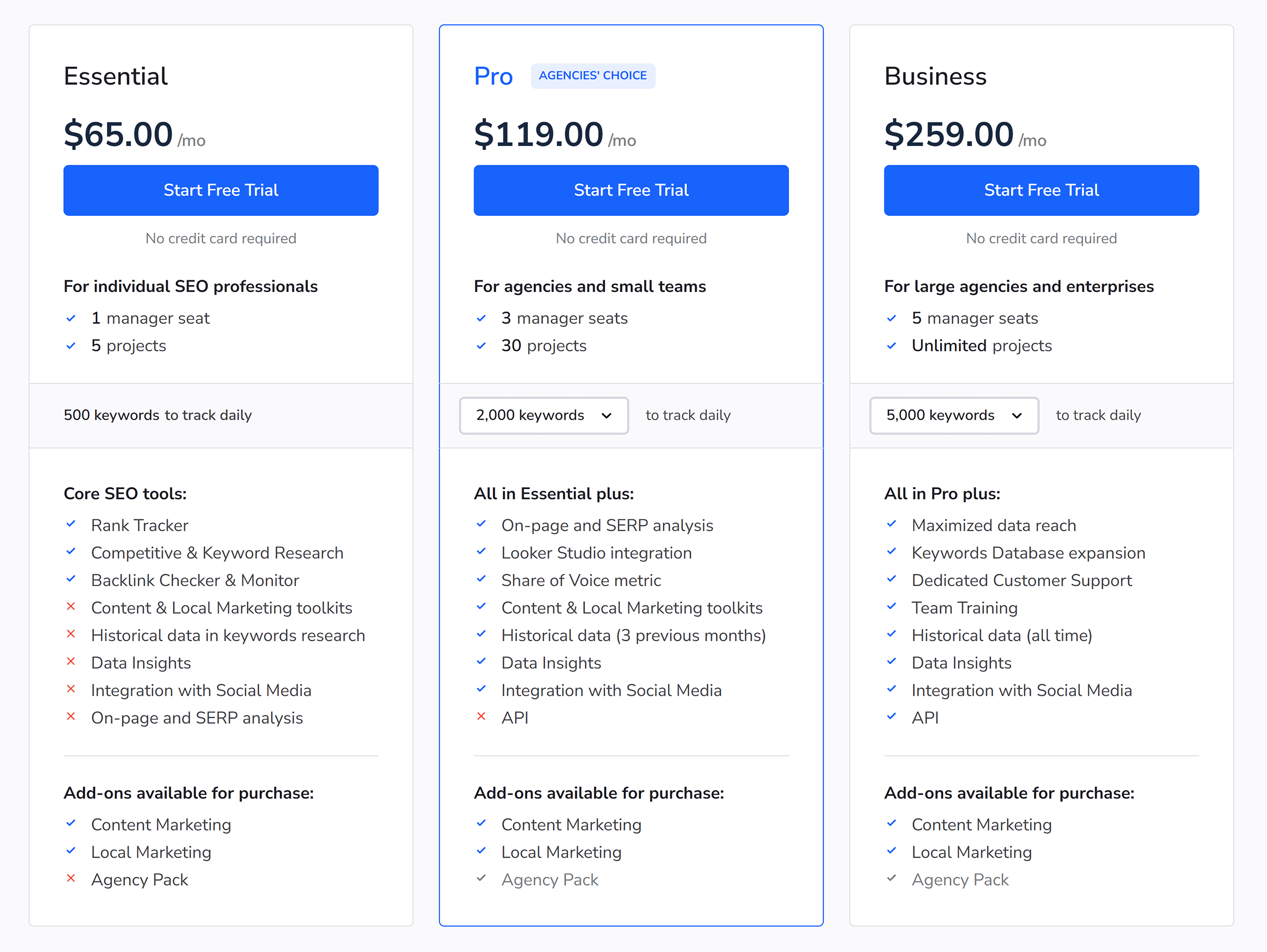
SE Ranking offers three pricing plans with a 14-day free trial:
Essential: For $65 per month, audit up to five projects Pro: For $119 per month, audit up to 30 projects. And white-label your reports. Business: For $259 per month, audit unlimited projects4. Conductor Website Monitoring, Powered by ContentKing
Best for getting customized, real-time alerts of website changes and issues.
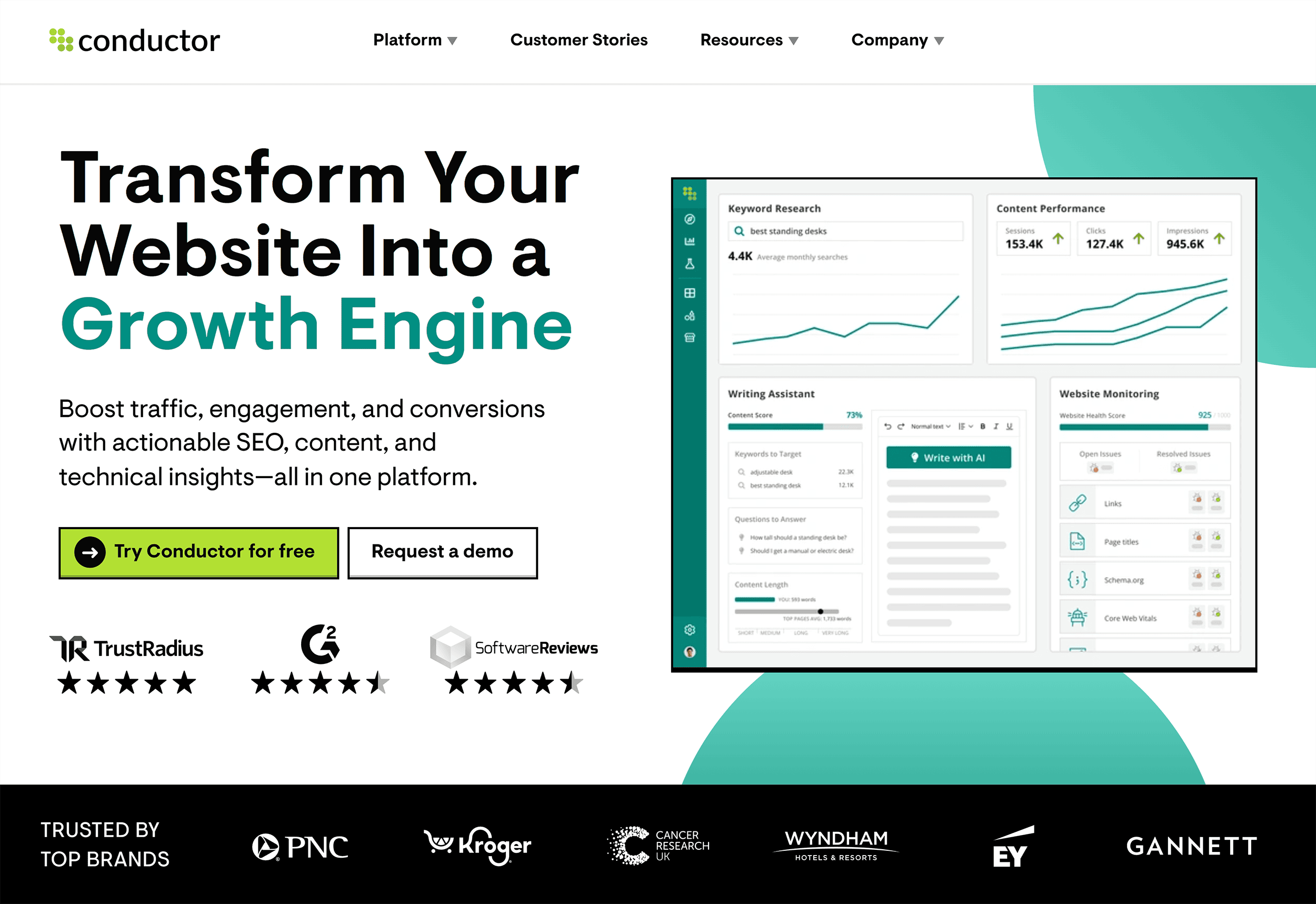
Conductor is an enterprise SEO platform. It helps you find technical issues, track keyword rankings, and improve your content strategy. Understand your competitors and monitor your SEO progress with custom reports.
Use Conductor to:
Get Real-Time Alerts
Navigate to “Alerts“” from the left-side menu. If there are any alerts (like status code errors, stale content, ecommerce issues), you’ll see them here. So you can fix them before these issues impact your website traffic and revenue.
Click “ALERT SETTINGS” at the top-right corner of the dashboard to customize your alerts.
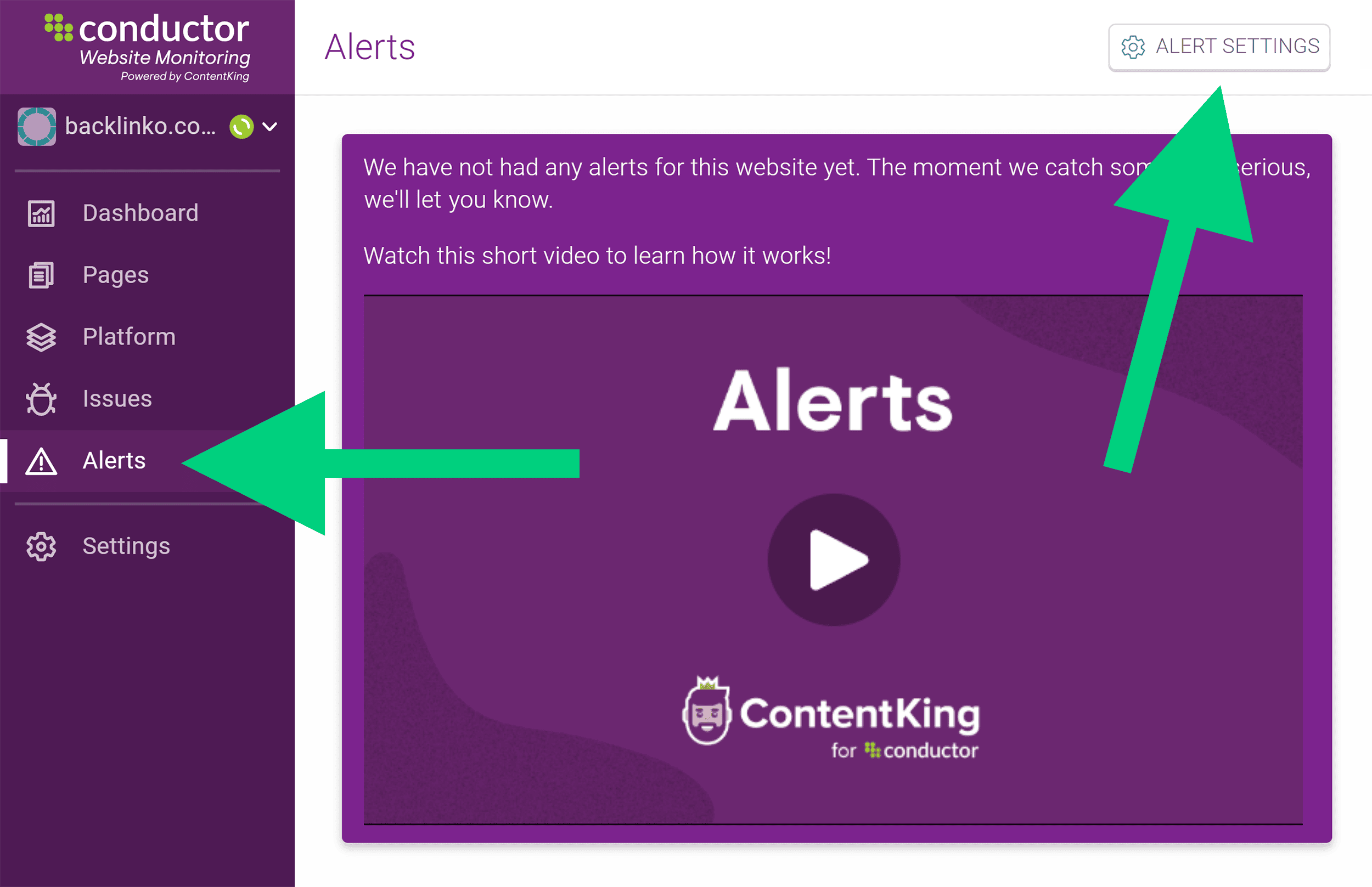
Click “CREATE ALERT DEFINITIONS” and select “Important pages” from the drop-down menu in the scope filter.

This way, you can focus on what truly matters and avoid unnecessary alerts. You’ll receive real-time alerts only for the pages that have the greatest impact on your website’s performance and goals.
If you want to customize alerts even more, click “+ CREATE ALERT DEFINITIONS” to select the types of alerts you want to receive.
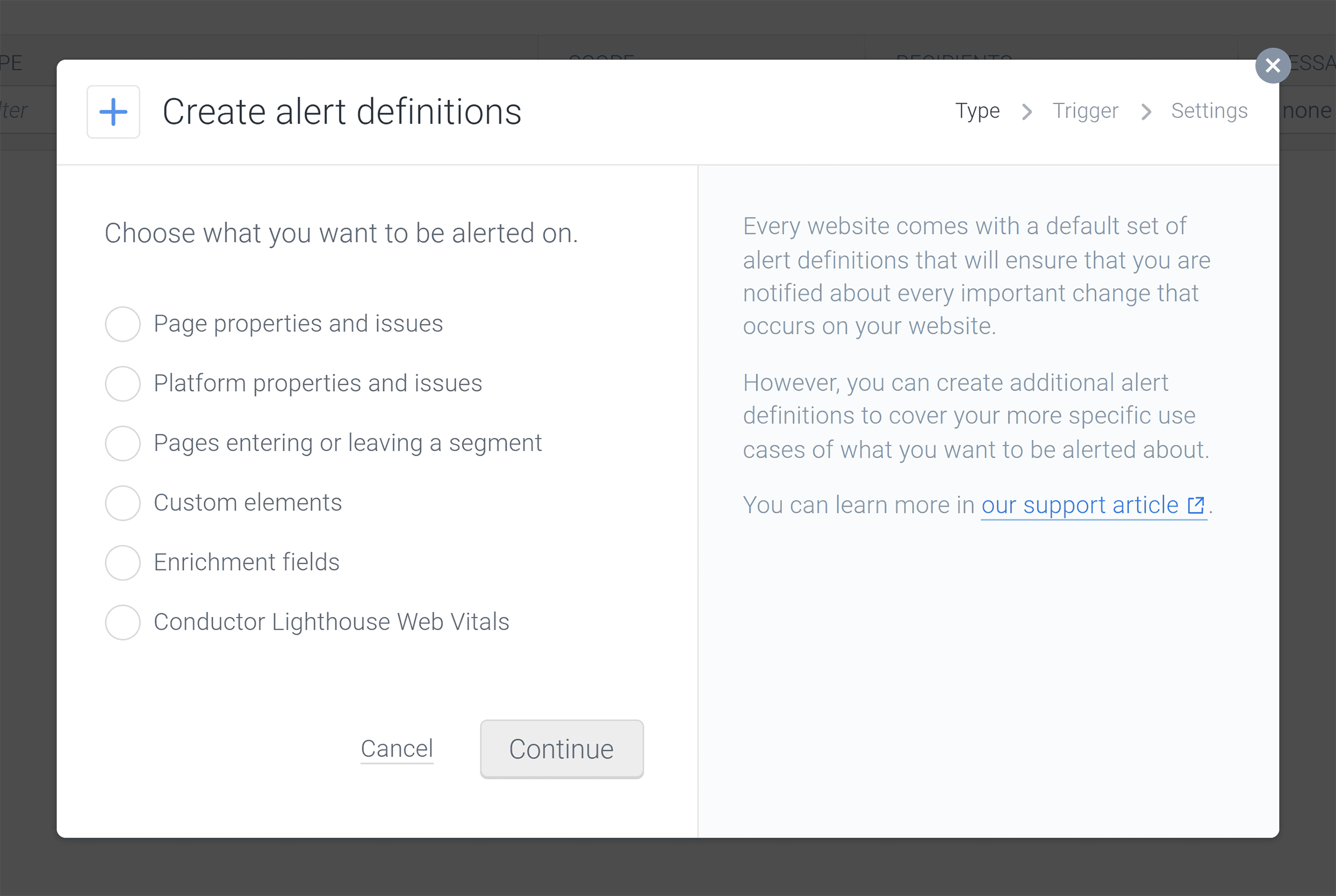
Select what you want to be alerted on and click “Continue.”
Discover Important Issues on Your Website
Navigate to “Issues” from the left side menu to see the issues that might be hindering your SEO performance.
Conductor organizes issues into thematic groups like analytics and content headings.
Click each group to review all the issues within that category.
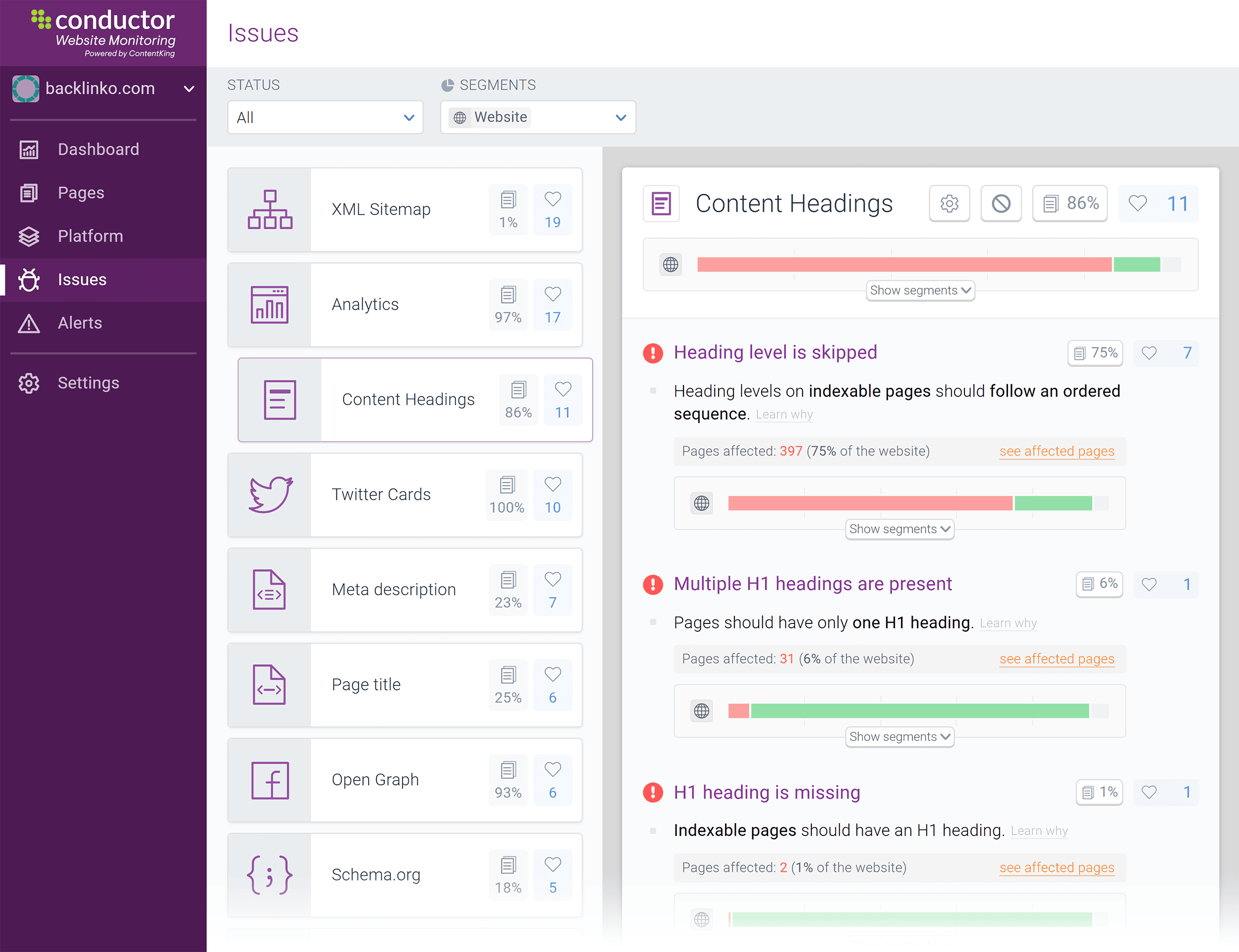
Pros and Cons
| Ability to customize alerts to get notified about the most important changes on your website | Conductor isn’t transparent on its pricing, but users report a steep price point |
| Ability to audit thousands of pages across multiple websites |
Price
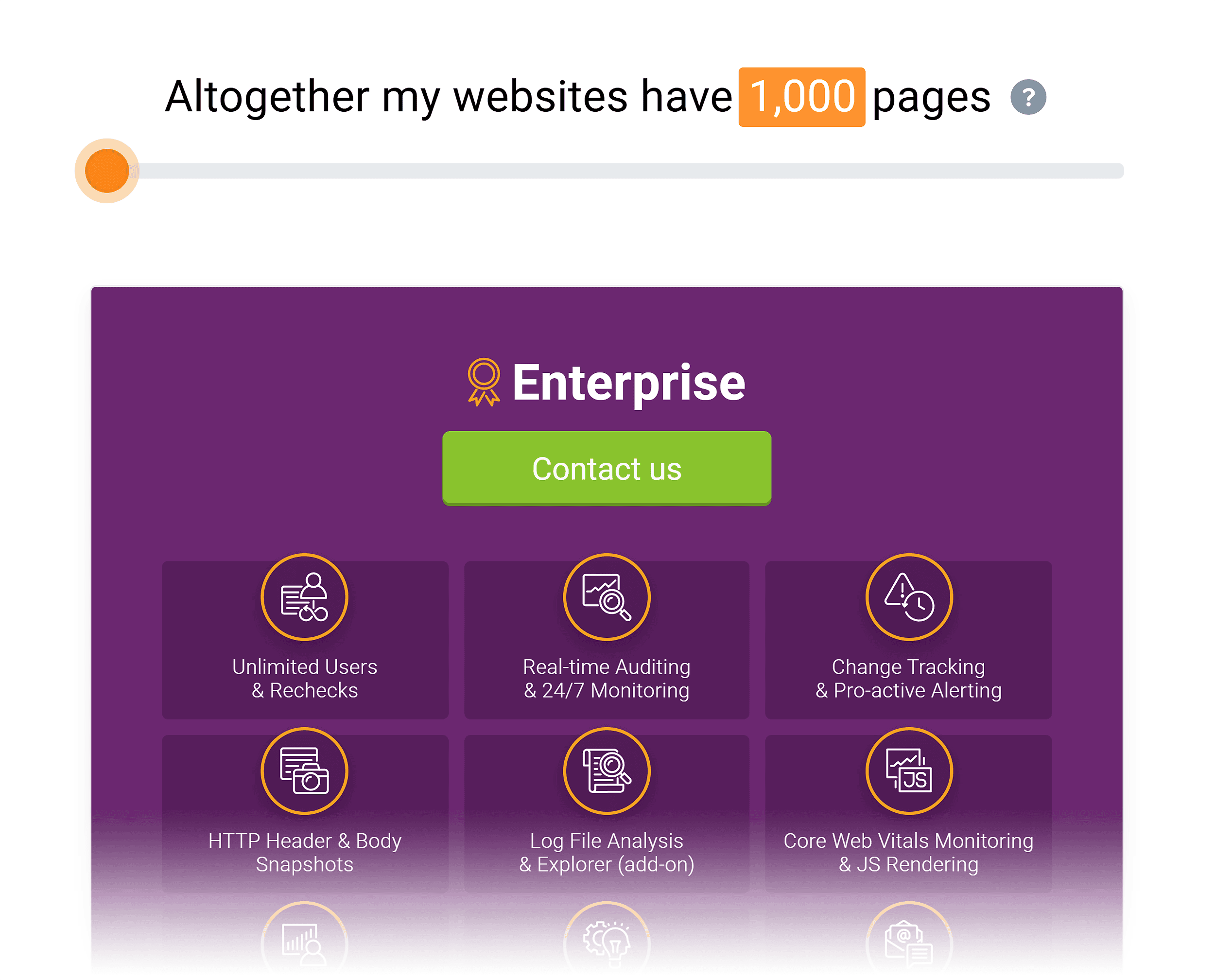
Conductor offers custom pricing based on the number of total web pages you need to audit. You can distribute the number of pages across multiple websites.
5. Google Search Console
Best for monitoring your site’s presence in Google Search.

Google Search Console (GSC) helps you monitor your website’s presence in Google search results.
With GSC, you can:
Identify technical issues Submit sitemaps Request indexing of new or updated pagesGoogle Search Console is a must-have tool for any website.
However, for a comprehensive SEO audit, we recommend you pair it with more advanced tools like Semrush.
While GSC provides insights into your site’s performance on Google, it lacks certain functionalities. Like prioritized lists of SEO issues. And actionable suggestions to fix them. Or backlink analysis.
But it’s absolutely worth using the following functions:
Make Sure Your Pages Are Indexed
In Google Search Console, click “Pages” under the “Indexing” section of the side navigation menu.
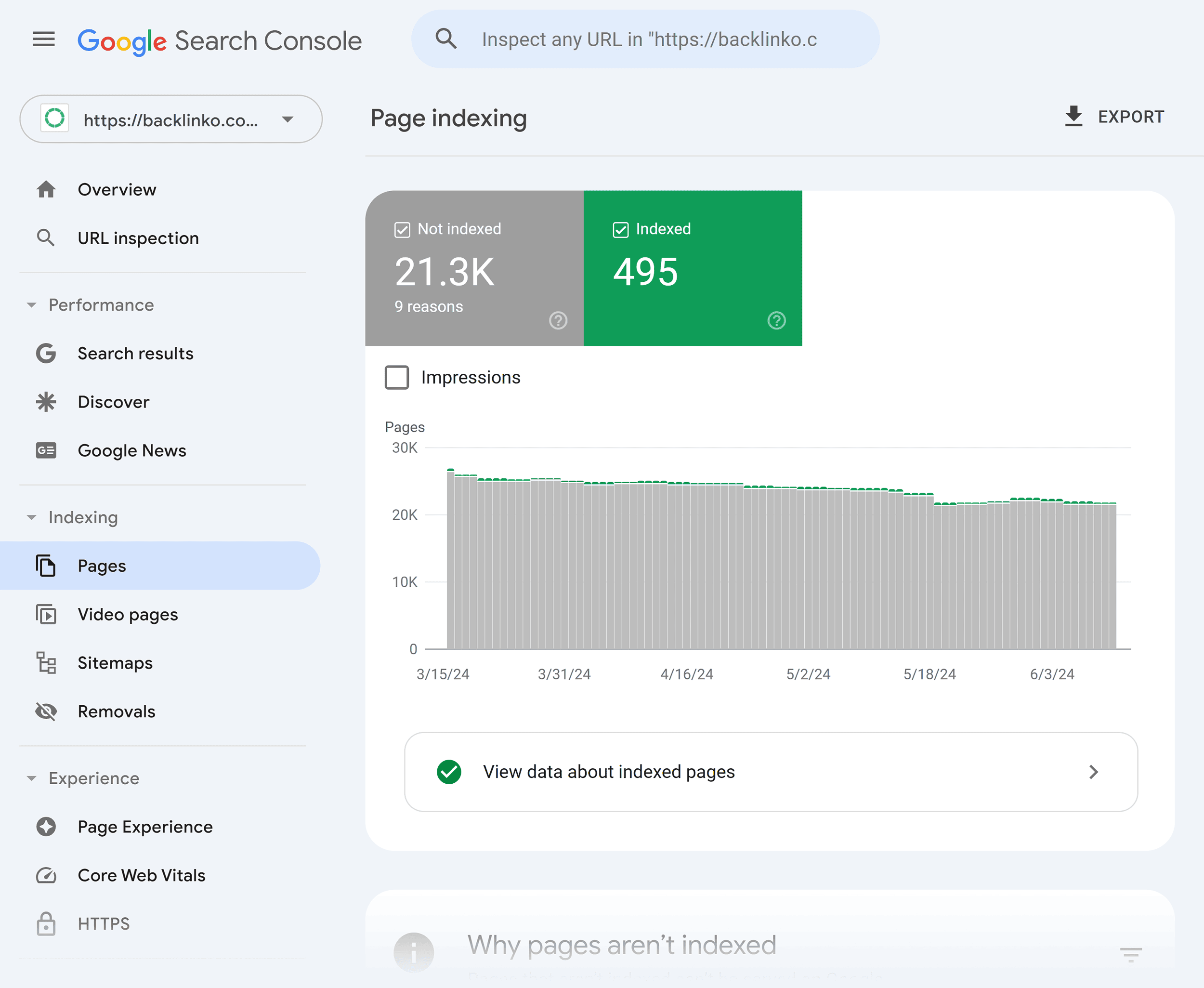
For example, it tells us that 21.3K of our pages are indexed. And 495 are not.
Scroll down the page to view the breakdown of non-indexed pages. And see why they’re not indexed.
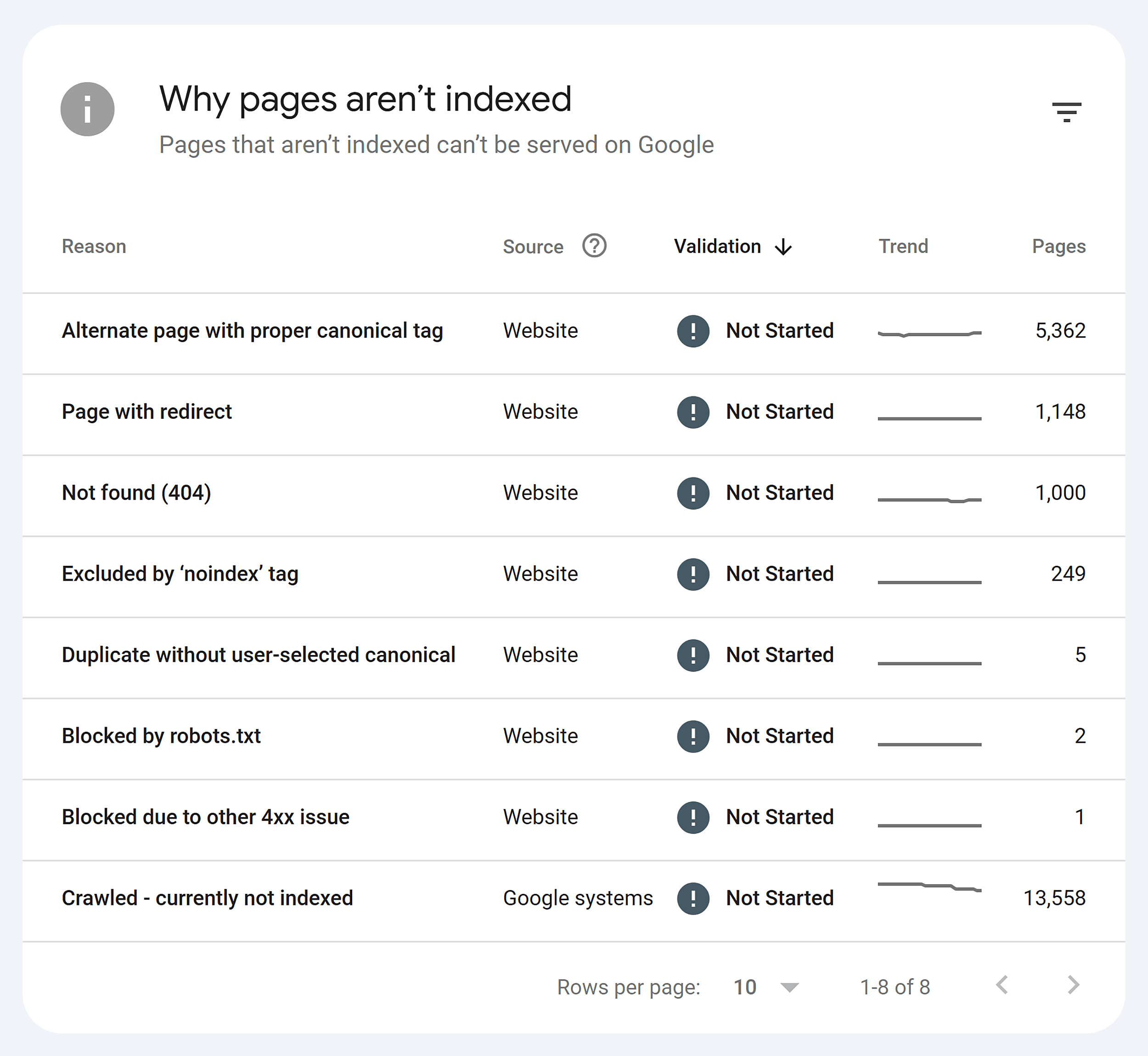
Then, click one of the reasons to see how many and which pages are affected. Like this:

From here, investigate each page by clicking on its URL, which will take you directly to the page on your website.
Determine if you should redirect, restore, or remove the page based on the reason it was flagged and its current content.
Check Your Website Performance
Navigate to the “Performance” and click on “Search results” report.

Here, you can see your website’s:
Total clicks Total impressions Average click-through rate (CTR) Average position
Use filters (which you can find on top of the performance chart) to refine your search performance data by:
Search type (web, image, video, news) Date Query (keyword included in search) Page (insert a specific URL) Country Device (desktop, mobile, tablet)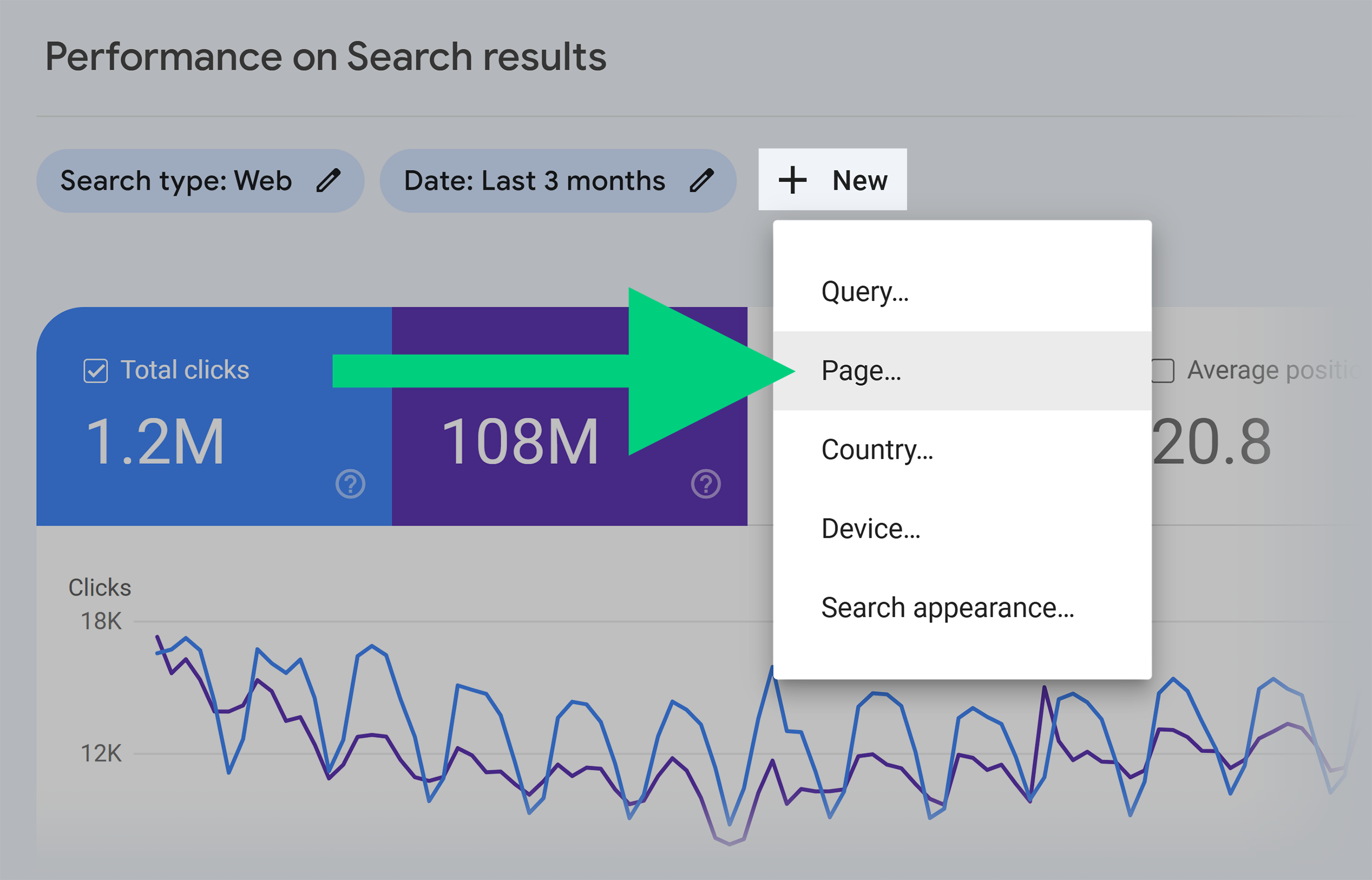
Share Your Performance
To share your SEO performance with your clients or team members, click “Export.” And select the file type of your choice.
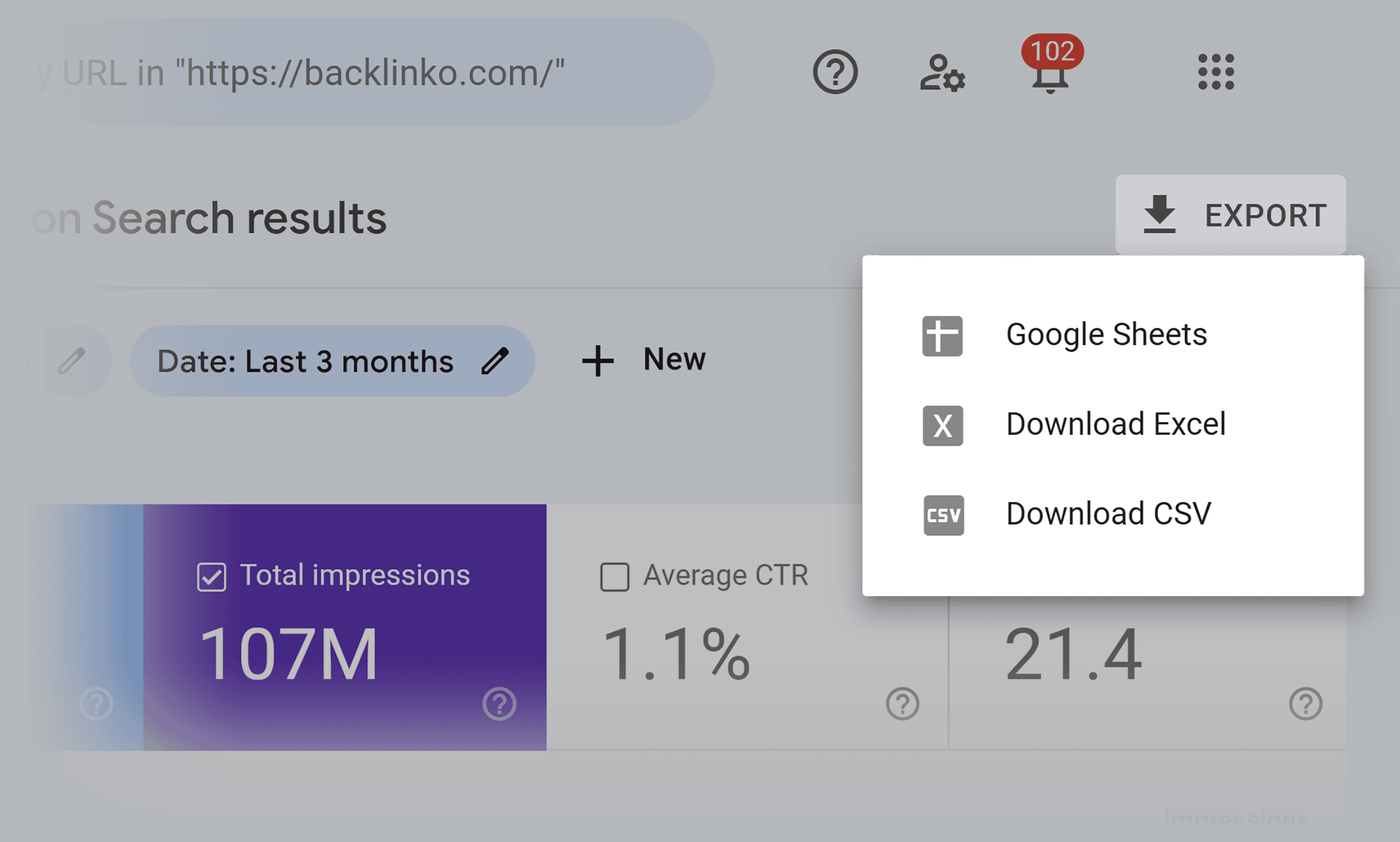
Pros and Cons
| Track website performance for free | Learning curve can be steep for beginners |
| Analyze all aspects of your SEO performance like impressions, clicks, and position | Doesn’t provide the list of issues and suggested fixes |
Price
Google Search Console is free.
Ready to Pick Your SEO Audit Tool?
Whether you’re a seasoned SEO pro or just starting out, these tools can:
Save you time Provide valuable insights Help you prioritize your optimization effortsBut choosing the right tool is just the first step. To do an efficient SEO audit, you also need a structured approach.
To help you out, we created the 18-step SEO audit checklist. Let it guide you through every stage of the process.

 KickT
KickT 

























.jpg&h=630&w=1200&q=100&v=154b70b92d&c=1)






